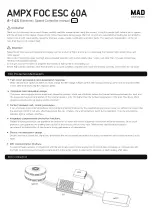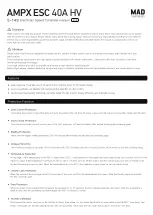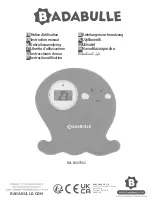
8016903/ZP97/2017-07-27 • Subject to change without notice •
SICK AG
•
Waldkirch
•
Germany
•
www.sick.com
T i M 3 5 x / T i M 3 6 x | S i C K
1
TiM35x
TiM36x
Intended use
The TiM35x/TiM36x laser scanner (referred to as the TiM
below) is an intelligent sensor for invisibly detecting objects
in areas (fields) to be monitored. The device is designed for
portable or stationary use indoors or outdoors in standalone
operation, with a scanning range of up to 10 m. The com-
bined control for the four switching inputs activates one of the
16 field sets for field monitoring. Each field set provides three
configurable fields. The TiM indicates detected field infringe
-
ments in relation to the three fields through a combination of
three switching outputs.
The TiM can also evaluate the existence of a contour, which
has to be fully situated within the evaluation field at all times.
This allows the TiM to detect, for example, that a door opens
outwards or that the position of the TiM has changed. It is
also possible to detect someone crawling beneath a vertical
evaluation field or a laser beam deflected in a mirror.
The TiM is available in both a PNP and an NPN variant. The
NPN variant is identified by S02 in the type code on the type
label.
The purpose of this instruction manual is to allow you to put
the TiM into operation quickly and easily using preconfigured
field sets and to obtain the first detection results.
Further information on the mechanical and electrical
installation is available in the
&
Technical Information
(no.
8014318). This information is available for download on the
TiM product page (www.sick.com/tim3xx).
The TiM is certified to IEC/EN/UL/CSA 61010-1:2007. These
operating instructions may contain passages of text in a
foreign language.
Safety information
• Read these instructions before commissioning the TiM
in order to familiarize yourself with the device and its
functions.
• The TiM corresponds to laser class 1 (
see
).
• Mounting and electrical installation are to be performed
only by qualified technicians.
•
Electrical connections between the TiM and other devices
may only be made when there is no power to the system.
Otherwise, the devices may be damaged.
• Wire cross-sections in the supply cable from the custom-
er's power system should be designed in accordance with
the applicable standards. Protect the TiM with an external
0.8 A slow-blow fuse at the beginning of the supply cable.
•
All circuits connected to the TiM must be designed as SELV
or PELV circuits. (SELV =
S
afety
E
xtra
L
ow
V
oltage, PELV =
P
rotective
E
xtra
L
ow
V
oltage).
•
Use the device only under permitted environmental
conditions (e.g. temperature, grounding potential,
see
• Protect the TiM against moisture and dust when the cover
to the USB socket is open. The black plastic cover must
be screwed flush in order to comply with enclosure rating
IP 67 in operation.
• Turn the swivel connector unit with the electrical connec-
tions max 180° from end position to end position.
• Opening the screws of the TiM housing will invalidate any
warranty claims against SICK AG.
• The TiM does not constitute personal protection equip-
ment in accordance with the respective applicable safety
standards for machines.
Commissioning and configuration
Step 1: Electrical installation
1. Connect the communication interface of the TiM to the
PC (Ethernet or USB; recommended Ethernet, 4-pin M12
female connector).
>
If using a USB, connect the TiM's Micro USB port (behind
the black plastic cover on the side) to a free USB port (type
A) on the PC using a suitable shielded high-speed USB
cable (e.g. no. 6036106, 2 m).
The USB cable must not exceed 3 m in length!
When operating the USB interface, be aware that ESD/
EMC influences may break the USB connection. To re-es
-
tablish the data transmission, remove the USB cable on
the TiM and plug it back into the contact. To re-establish
communication between TiM and PC in the SOPAS configu
-
ration software, select
C
ommuniCation
> G
o
o
nline
.
2.
Turn on and start the PC.
3.
Provide power to the TiM (12-pin M12 male connector).
Using the power supply unit it must be ensured that the
supply voltage does not drop below 8 V for longer than
2 ms and never rises above 30 V.
Following successful initialization, the green LED lights up
"
▸
" (device ready for operation).
Do not supply the switching inputs with current yet.
SOPAS
SOPAS
“Power/I/O”
“USB 2.0”
Configuration
Field monitoring
Diagnosis
TiM
Connection
box
USB
USB
DC 9 ... 28 V
...
IN 1 IN 4
OUT 1 OUT 3
customer-
provided
OUT 2 OUT 4
delay-
action
fuse
0,8A/T
IN GND
Electrical block diagram for commissioning PNP variant
TiMxS02
IN
9 ... 28 V
SOPAS
SOPAS
“Power/I/O”
“USB 2.0”
Configuration
Field monitoring
Diagnosis
Connection
box
USB
USB
DC 9 ... 28 V
...
IN 1 IN 4
OUT 1 OUT 3
customer-
provided
OUT 2 OUT 4
delay-
action
fuse
0,8A/T
Electrical block diagram for commissioning NPN variant
Step 2: Mounting and alignment
NOTE
During installation make sure there is no reflective surface
behind the reference target
see
â
.
1.
Optional: Mount the TiM to separately ordered mounting
accessories (mounting kit 2), see "Mounting" Chapter in
the
&
Technical Information
(no. 8014318).
2.
Otherwise, mount the two straight plates from the
enclosed mounting kit 1 on the TiM using two M3 screws.
Use the two blind-hole threads either on the underside or
back of the housing (
. If
the straight plates are not used, screw the screws provided
by the customer max. 2.8 mm into the thread
.
3. Mount the TiM on a prepared bracket.
The device should be as free from vibration as possible
during operation.
4. Align the 90° axis of the TiM's scanning angle with the
center of the area to be monitored. The marking on the
lid of the optical hood serves as a bearing alignment aid
(
0
Scanning range in m (feet)
Scanning range in m (feet)
0
Scanning range max. 10 m (32.81 feet)
Scanning range typical 8 m (26.25 feet)
for objects up to 10 % remission
180°
‒45°
225°
270°
90°
0°
6
(19.69)
6
(19.69)
2
(6.56)
2
(6.56)
2
(6.56)
2
(6.56)
6
(19.69)
10
(32.81)
14
(45.93)
10
(32.81)
14
(45.93)
6
(19.69)
14
(45.93)
14
(45.93)
10
(32.81)
10
(32.81)
Range diagram for TiM
Detecting Laser Scanner
Short Range
OPERATiNG iNSTRUCTiONS
en
























